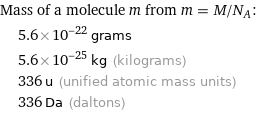Input interpretation

titanium(IV) 2-ethyl-1, 3-hexanediolate | molar mass
Result
![Find the molar mass, M, for titanium(IV) 2-ethyl-1, 3-hexanediolate: M = sum _iN_im_i Plan: • Write the chemical formula and gather atomic masses from the periodic table. • Determine values for N_i and m_i using these items. • Finally, compute the mass. Write the chemical formula: Ti[RCH_2CH(C_2H_5)CH(R')CH_2CH_2CH_3]_4, R=(OH, O-), R'=(O-, OH) Use the chemical formula, Ti[RCH_2CH(C_2H_5)CH(R')CH_2CH_2CH_3]_4, R=(OH, O-), R'=(O-, OH), to count the number of atoms, N_i, for each element: | N_i C (carbon) | 16 H (hydrogen) | 32 O (oxygen) | 4 Ti (titanium) | 1 Look up the atomic mass, m_i, in g·mol^(-1) for each element in the periodic table: | N_i | m_i/g·mol^(-1) C (carbon) | 16 | 12.011 H (hydrogen) | 32 | 1.008 O (oxygen) | 4 | 15.999 Ti (titanium) | 1 | 47.867 Multiply N_i by m_i to compute the mass for each element. Then sum those values to compute the molar mass, M: Answer: | | | N_i | m_i/g·mol^(-1) | mass/g·mol^(-1) C (carbon) | 16 | 12.011 | 16 × 12.011 = 192.176 H (hydrogen) | 32 | 1.008 | 32 × 1.008 = 32.256 O (oxygen) | 4 | 15.999 | 4 × 15.999 = 63.996 Ti (titanium) | 1 | 47.867 | 1 × 47.867 = 47.867 M = 192.176 g/mol + 32.256 g/mol + 63.996 g/mol + 47.867 g/mol = 336.295 g/mol](../image_source/f62e99835ac9a8a33d1ec77b73c5e537.png)
Find the molar mass, M, for titanium(IV) 2-ethyl-1, 3-hexanediolate: M = sum _iN_im_i Plan: • Write the chemical formula and gather atomic masses from the periodic table. • Determine values for N_i and m_i using these items. • Finally, compute the mass. Write the chemical formula: Ti[RCH_2CH(C_2H_5)CH(R')CH_2CH_2CH_3]_4, R=(OH, O-), R'=(O-, OH) Use the chemical formula, Ti[RCH_2CH(C_2H_5)CH(R')CH_2CH_2CH_3]_4, R=(OH, O-), R'=(O-, OH), to count the number of atoms, N_i, for each element: | N_i C (carbon) | 16 H (hydrogen) | 32 O (oxygen) | 4 Ti (titanium) | 1 Look up the atomic mass, m_i, in g·mol^(-1) for each element in the periodic table: | N_i | m_i/g·mol^(-1) C (carbon) | 16 | 12.011 H (hydrogen) | 32 | 1.008 O (oxygen) | 4 | 15.999 Ti (titanium) | 1 | 47.867 Multiply N_i by m_i to compute the mass for each element. Then sum those values to compute the molar mass, M: Answer: | | | N_i | m_i/g·mol^(-1) | mass/g·mol^(-1) C (carbon) | 16 | 12.011 | 16 × 12.011 = 192.176 H (hydrogen) | 32 | 1.008 | 32 × 1.008 = 32.256 O (oxygen) | 4 | 15.999 | 4 × 15.999 = 63.996 Ti (titanium) | 1 | 47.867 | 1 × 47.867 = 47.867 M = 192.176 g/mol + 32.256 g/mol + 63.996 g/mol + 47.867 g/mol = 336.295 g/mol
Unit conversion

0.3363 kg/mol (kilograms per mole)
Comparisons

≈ 0.47 × molar mass of fullerene ( ≈ 721 g/mol )

≈ 1.7 × molar mass of caffeine ( ≈ 194 g/mol )

≈ 5.8 × molar mass of sodium chloride ( ≈ 58 g/mol )
Corresponding quantities

Mass of a molecule m from m = M/N_A: | 5.6×10^-22 grams | 5.6×10^-25 kg (kilograms) | 336 u (unified atomic mass units) | 336 Da (daltons)

Relative molecular mass M_r from M_r = M_u/M: | 336